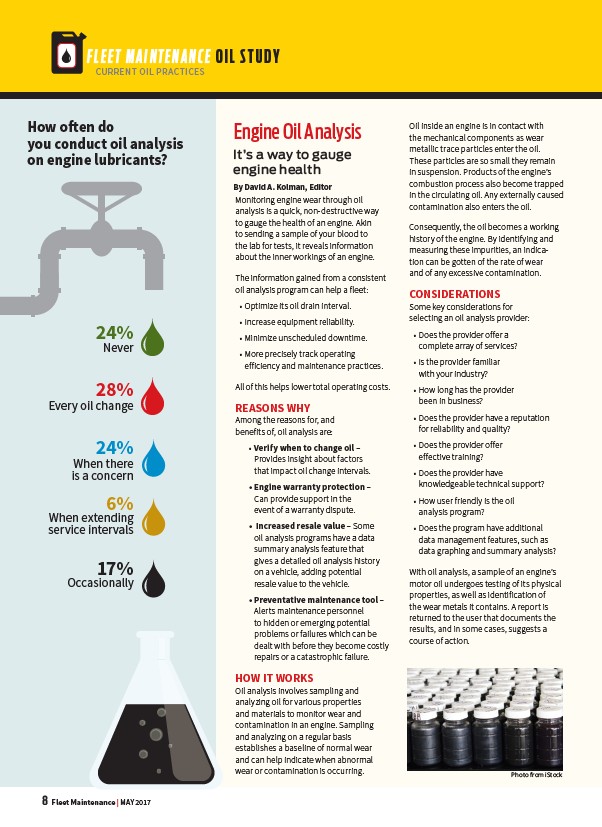
FLEET MAINTENANCE O IL STUDY
CURRENT OIL PRACTICES
8 Fleet Maintenance | MAY 2017
Monitoring engine wear through oil
analysis is a quick, non-destructive way
to gauge the health of an engine. Akin
to sending a sample of your blood to
the lab for tests, it reveals information
about the inner workings of an engine.
The information gained from a consistent
oil analysis program can help a fleet:
• Optimize its oil drain interval.
• Increase equipment reliability.
• Minimize unscheduled downtime.
• More precisely track operating
efficiency and maintenance practices.
All of this helps lower total operating costs.
REASONS WHY
Among the reasons for, and
benefits of, oil analysis are:
• Verify when to change oil –
Provides insight about factors
that impact oil change intervals.
• Engine warranty protection –
Can provide support in the
event of a warranty dispute.
• Increased resale value – Some
oil analysis programs have a data
summary analysis feature that
gives a detailed oil analysis history
on a vehicle, adding potential
resale value to the vehicle.
• Preventative maintenance tool –
Alerts maintenance personnel
to hidden or emerging potential
problems or failures which can be
dealt with before they become costly
repairs or a catastrophic failure.
HOW IT WORKS
Oil analysis involves sampling and
analyzing oil for various properties
and materials to monitor wear and
contamination in an engine. Sampling
and analyzing on a regular basis
establishes a baseline of normal wear
and can help indicate when abnormal
wear or contamination is occurring.
Oil inside an engine is in contact with
the mechanical components as wear
metallic trace particles enter the oil.
These particles are so small they remain
in suspension. Products of the engine’s
combustion process also become trapped
in the circulating oil. Any externally caused
contamination also enters the oil.
Consequently, the oil becomes a working
history of the engine. By identifying and
measuring these impurities, an indication
can be gotten of the rate of wear
and of any excessive contamination.
CONSIDERATIONS
Some key considerations for
selecting an oil analysis provider:
• Does the provider offer a
complete array of services?
• Is the provider familiar
with your industry?
• How long has the provider
been in business?
• Does the provider have a reputation
for reliability and quality?
• Does the provider offer
effective training?
• Does the provider have
knowledgeable technical support?
• How user friendly is the oil
analysis program?
• Does the program have additional
data management features, such as
data graphing and summary analysis?
With oil analysis, a sample of an engine’s
motor oil undergoes testing of its physical
properties, as well as identification of
the wear metals it contains. A report is
returned to the user that documents the
results, and in some cases, suggests a
course of action.
It’s a way to gauge
engine health
By David A. Kolman, Editor
How oft en do
you conduct oil analysis
on engine lubricants?
Engine Oil Analysis
24%
Never
28%
Every oil change
24%
When there
is a concern
6%
When extending
service intervals
17%
Occasionally
Photo from iStock